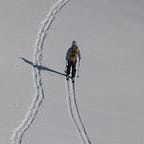What’s next for BC Parks in an era of declining budgets and continued growth of the tourism industry?
The provincial government released their annual budget today. For BC Parks, they have actually implemented a small decrease in funding compared to last year (from $41.6 million down to $40.7 million) Going forward, that level will be maintained (with a $0.2 million increase next year) until the end of the forecast period (22/23). After accounting for inflation, this represents an additional decrease in funding next year and the year after.
Given a declining budget, something else has to change.
Today, our parks are suffering from an increasing burden of deferred maintenance with each passing year and many trails and campgrounds are seeing unmanageable quantities of visitors in peak periods. At the same time, tourism continues to boom and DestinationBC has set a target of 6% tourism industry growth for each of the next three years. The status quo is not an option for the management of the park system.
Given that the budget decision has been made, what are the other levers we can work with? I present four options below. I dislike all of these options but which one do you think is the least bad?
Quotas and closures:
One way to manage a park system with an undersized budget is to limit visitors through park closures and quotas. One example of this is Brandywine Falls Provincial Park. If the park was open then BC Parks would need to pay to plow the parking lot and maintain the outhouse and the park would see thousands of visitors. Instead, the gate is closed for the entire winter and people who park outside the gate are towed away. Other examples are the introductions of mandatory reservations and the phasing out of overflow camping areas. When this is taken to the extreme, visitors will need to enter a lottery each year and it may take years before they win an opportunity to visit a given park.
Downside: Limits how many people can enjoy the parks.
Downgrade facilities:
If the money does not exist to maintain and operate the current park facilities, they can be downgraded. In many cases, this has the knock-on impact of also reducing crowds to more manageable levels. If BC Parks does not have money to maintain two bridges, they can pull one of them out and only maintain the remaining one. Flush washrooms can be replaced with outhouses. Roads can go unmaintained so that only 4WD vehicles can access them. Winter routes can go unmarked so that visitors must be self reliant and capable of navigating on their own. etc.
Downside: Limits access based on fitness, experience, and equipment.
Increase fees:
As an example, it is estimated that 2000 people used to use the Rubble Creek Trail in the winter and that plowing would cost $12,000 to $18,000. Put another way: A $6–$9/person parking fee would allow that trailhead to be maintained. Throughout the park system, fees can be implemented to pay for services (this would include fees for accessing a trail to go on a day hike).
Downside: Limits access based on ability to pay.
Commercialize the park system:
It is tempting to suggest that we should allow commercial interests to operate in the park system to generate revenue. Advertising at campgrounds. Private huts. etc. The best example of this today is the three park use permits that allow corporations to operate ski hills inside of provincial parks (Cypress, Seymour and Manning.) The reality is that those operations generate very little revenue for the province. Total combined revenue for BC Parks in 17/18 from the three ski hills was $0.3 million.
Downside: Goes against the entire point of setting aside land for parks.
What do you think should be done?
Happy Hiking,
Steve
stevejoneshikes@gmail.com
